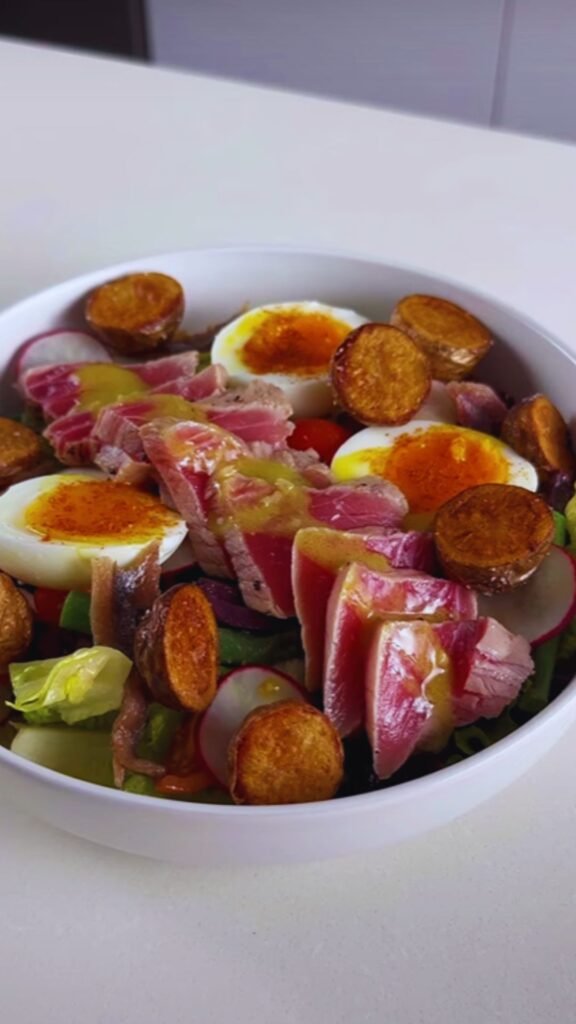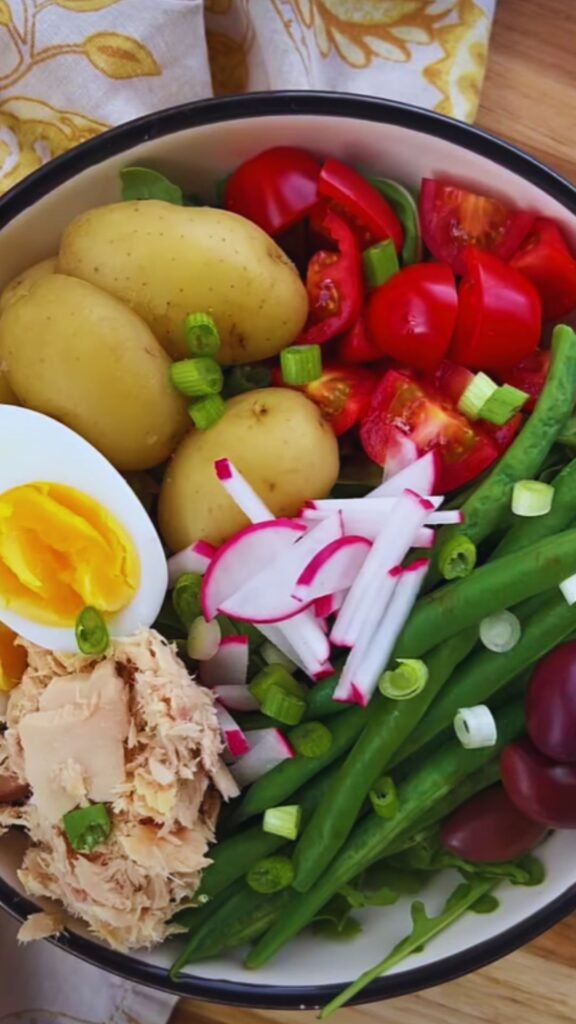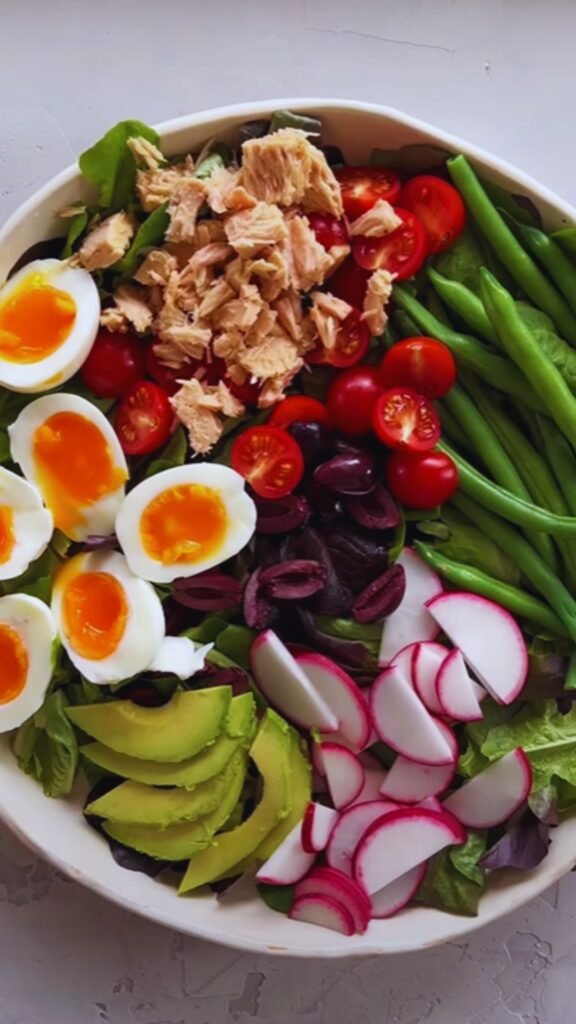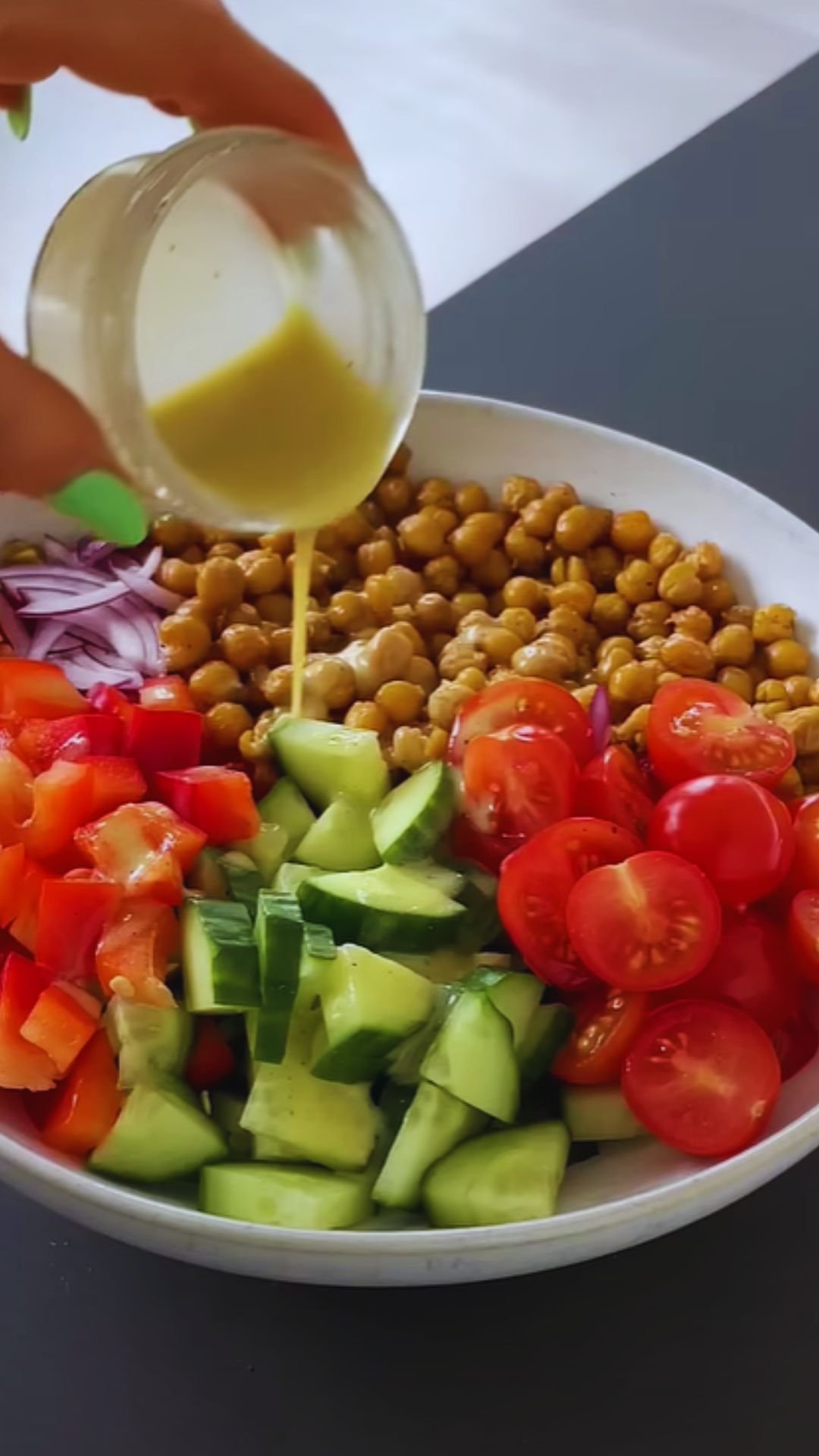There’s something truly magical about the first bite of a properly made Niçoise salad on a hot summer day. The briny olives, tender potatoes, crisp green beans, and perfectly seared tuna come together in a harmony of flavors that transport me straight to the French Riviera. Today, I’m excited to share my perfected summer Niçoise salad recipe that has become a staple at my warm-weather gatherings.
As someone who has spent countless hours refining this classic dish, I can tell you that while it appears sophisticated, a Niçoise salad is surprisingly straightforward to prepare. The key lies in understanding the traditional components and preparing each element with care. This isn’t just any salad—it’s a complete meal that celebrates the bounty of summer produce while honoring its Mediterranean roots.
The History Behind the Dish
The Niçoise salad originates from Nice, a coastal city in the south of France. Traditionally, this salad featured raw vegetables, anchovies, and olive oil—a simple combination that reflected the local produce of the French Riviera. The name “Niçoise” itself refers to something or someone from Nice.
Over time, this humble salad evolved as chefs began incorporating cooked elements like potatoes and green beans. The addition of tuna—either canned or fresh—became popular outside of France, transforming what was once a simple appetizer into a substantial main course.
What I love most about the Niçoise salad is how it represents the sunny Mediterranean diet: fresh vegetables, healthy proteins, and heart-healthy olive oil. It’s a perfect example of how simple, quality ingredients can create something truly exceptional.
Key Ingredients: Traditional vs. Modern
The best Niçoise salads balance respect for tradition with thoughtful adaptation. Here’s a comparison of traditional ingredients versus common modern variations:
| Traditional Ingredients | Modern Adaptations | My Recommendation |
|---|---|---|
| Canned tuna in olive oil | Seared fresh tuna | Fresh seared tuna for summer, high-quality canned in winter |
| Small black Niçoise olives | Kalamata olives | Stick with authentic Niçoise if available |
| Anchovies | Often omitted | Keep them! They provide essential umami |
| Raw artichoke hearts | Steamed artichokes or omitted | Optional but delightful addition |
| Green bell peppers | Varied colored peppers | Stick with traditional green for authenticity |
| Hard-boiled eggs | Soft-boiled eggs | Jammy 7-minute eggs for best texture |
| Raw tomatoes | Same | Must be ripe and in-season |
| Celery | Often omitted | Optional but adds nice crunch |
| Cucumber | Same | Persian or English varieties work best |
| Red onion | Spring onions or shallots | Thinly sliced shallots provide subtlety |
| Olive oil dressing | Vinaigrettes with Dijon | Classic Dijon vinaigrette with quality olive oil |
While I appreciate authenticity, my recipe incorporates elements from both traditional and modern approaches. I find this creates the most delicious version while still honoring the salad’s roots.
Essential Equipment
Before diving into preparation, gather these kitchen tools:
- Large pot for boiling potatoes and eggs
- Steamer basket or second pot for green beans
- Sharp knife and cutting board
- Mixing bowls (various sizes)
- Whisk for dressing
- Cast iron skillet or grill pan (if using fresh tuna)
- Serving platter or individual plates
The Perfect Summer Niçoise Salad Recipe
Ingredients (Serves 4)
For the Salad:
- 1 pound small new potatoes
- 8 ounces fresh green beans, trimmed
- 4 large eggs
- 1 pound fresh tuna steak (about 1-inch thick)
- 2 heads Boston or Bibb lettuce, washed and dried
- 8 ounces cherry tomatoes, halved
- 1 English cucumber, sliced
- 1/2 small red onion, thinly sliced
- 1/2 cup Niçoise olives (or small black olives)
- 8 anchovy fillets (optional but recommended)
- 2 tablespoons capers, rinsed and drained
- Fresh herbs for garnish (basil, chives, parsley)
For the Dijon Vinaigrette:
- 1/4 cup extra virgin olive oil
- 2 tablespoons fresh lemon juice
- 1 tablespoon white wine vinegar
- 1 teaspoon Dijon mustard
- 1 small shallot, minced
- 1 garlic clove, finely grated
- 1 teaspoon fresh thyme leaves
- Salt and freshly ground black pepper to taste
Method
Step 1: Prepare the Vegetables
- Place the potatoes in a large pot of cold, salted water. Bring to a boil and cook until fork-tender, about 15-20 minutes.
- While the potatoes cook, prepare an ice bath in a large bowl.
- During the last 3 minutes of cooking the potatoes, add the trimmed green beans to the pot (or steam them separately).
- Drain the potatoes and green beans and immediately plunge the green beans into the ice bath to stop the cooking and preserve their bright color.
- Once cool, drain the green beans thoroughly and pat dry.
- Allow potatoes to cool slightly, then cut them in half or quarters depending on size.
Step 2: Cook the Eggs
- In a separate pot, bring water to a boil.
- Gently lower eggs into the boiling water and cook for exactly 7 minutes for jammy centers (or 9 minutes for fully hard-boiled).
- Transfer eggs to an ice bath, then peel and quarter once cooled.
Step 3: Prepare the Tuna
- Pat the tuna steak dry with paper towels and season generously with salt and pepper.
- Heat a cast-iron skillet over high heat until smoking hot.
- Add a tablespoon of olive oil to the pan, then sear the tuna for 1-2 minutes per side for a rare to medium-rare center.
- Transfer to a cutting board and let rest for 5 minutes before slicing against the grain.

Step 4: Make the Vinaigrette
- In a small bowl, whisk together lemon juice, vinegar, Dijon mustard, minced shallot, grated garlic, and thyme.
- Slowly drizzle in the olive oil while whisking continuously to emulsify.
- Season with salt and freshly ground black pepper to taste.
- Set aside to allow flavors to meld.
Step 5: Assemble the Salad
- Line a large serving platter or individual plates with Boston or Bibb lettuce leaves.
- Arrange the potatoes, green beans, tomatoes, and cucumber on top of the lettuce.
- Place the quartered eggs around the perimeter.
- Add the tuna slices to the center of the platter.
- Scatter olives, capers, and red onion slices throughout.
- If using, drape anchovy fillets across the top.
- Drizzle everything with the prepared vinaigrette.
- Garnish with fresh herbs just before serving.

Tips for Niçoise Salad Perfection
Having made this salad countless times, I’ve learned several secrets that elevate it from good to exceptional:
Temperature Matters
The ideal temperature for serving a Niçoise salad is slightly chilled but not cold. I always allow the components to come to cool room temperature before assembling, which lets the flavors shine.
Potato Technique
For perfect salad potatoes, start them in cold water, which helps them cook evenly. After draining, toss the warm potatoes with a small amount of the vinaigrette—they’ll absorb the dressing and be more flavorful.
Green Bean Doneness
Green beans should be cooked until tender-crisp—they should still have a slight snap but not taste raw. The quick ice bath after cooking prevents them from becoming dull and limp.
Egg Perfection
The ideal egg for a Niçoise salad has a fully set white but a slightly jammy yolk. This takes exactly 7 minutes in boiling water followed by an immediate ice bath.
Tuna Variations
While I prefer seared fresh tuna in summer, high-quality oil-packed tuna makes an excellent alternative. If using canned, look for line-caught tuna in olive oil and gently break it into chunks rather than flaking it too finely.
Seasonal Adaptations
One of the joys of this salad is how it can evolve with the seasons:
Spring Variation
- Replace standard potatoes with small fingerlings
- Use tender spring lettuces
- Add blanched asparagus
- Incorporate fresh peas
Late Summer Adaptation
- Use heirloom tomatoes in various colors
- Add roasted red peppers
- Include fresh corn kernels
- Try with grilled tuna
Fall Version
- Add roasted butternut squash cubes
- Include lightly blanched kale
- Try with smoked trout instead of tuna
- Add pickled red onions
Serving Suggestions
A beautiful Niçoise salad deserves thoughtful presentation. Here are my favorite serving ideas:
- For casual gatherings, arrange on a large wooden board or platter for a rustic, abundant look
- For elegant dinner parties, plate individually with components artfully arranged
- Serve with crusty French baguette and unsalted butter
- Offer a sparkling water with lemon or lime wedges
- Fresh-squeezed lemonade makes a perfect companion
- Iced herbal tea with mint complements the Mediterranean flavors beautifully
Common Questions About Niçoise Salad
Q: Can I make components of the salad ahead of time? Absolutely! You can cook the potatoes, beans, and eggs up to a day ahead and refrigerate them separately. The dressing can be made up to three days in advance. Just bring everything to room temperature before assembling.
Q: Is it authentic to use fresh tuna instead of canned? Traditionalists might argue that canned tuna is more authentic, but both versions have their merits. In Nice itself, you’ll find variations with either fresh or preserved tuna, or sometimes anchovies alone.
Q: My anchovies are very salty. How can I reduce their saltiness? You can soak anchovies in milk for about 30 minutes to reduce their saltiness while preserving their flavor. Be sure to pat them dry afterward.
Q: What can I substitute for Niçoise olives if I can’t find them? Kalamata olives make a good substitute, though they’re larger and have a slightly different flavor profile. Any small, briny black olive will work in a pinch.
Q: How do I know when my tuna is perfectly cooked? For optimal texture, sear tuna for 1-2 minutes per side over high heat. The outside should be browned while the center remains pink. The tuna should feel slightly firm but with some give when pressed.
Q: Can I make a vegetarian version? Yes! Replace the tuna and anchovies with grilled halloumi cheese or marinated artichoke hearts. Add some chickpeas for protein.
Q: What’s the best way to arrange the salad for presentation? Traditional Niçoise salads are arranged with components grouped separately rather than tossed, allowing diners to appreciate each element. I like to place lettuce on the bottom, with other components arranged in distinct sections across the top.
Nutritional Benefits
The Niçoise salad isn’t just delicious—it’s also packed with nutrients:
| Ingredient | Key Nutrients | Health Benefits |
|---|---|---|
| Tuna | Omega-3 fatty acids, protein, selenium, vitamin D | Heart health, muscle building, immune support |
| Eggs | Protein, choline, lutein, zeaxanthin | Brain health, eye health |
| Green beans | Vitamin C, vitamin K, fiber | Gut health, bone strength |
| Potatoes | Potassium, vitamin C, vitamin B6 | Electrolyte balance, immune support |
| Olives | Monounsaturated fats, vitamin E | Heart health, antioxidant protection |
| Tomatoes | Lycopene, vitamin C, potassium | Cellular protection, heart health |
| Olive oil | Monounsaturated fats, polyphenols | Reduced inflammation, heart protection |
This nutritional profile makes Niçoise salad not just a culinary delight but also a well-balanced meal that supports overall health and wellbeing.
The Art of Ingredient Selection
I’ve learned through experience that the quality of ingredients makes an enormous difference in a dish as simple as Niçoise salad. Here are my guidelines for selecting each component:
Tuna
Whether using fresh or canned, quality matters tremendously. For fresh tuna, look for bright, almost translucent meat with no brown spots or strong fishy smell. If using canned, select sustainably caught tuna packed in olive oil rather than water for superior flavor.
Potatoes
Small, waxy varieties like fingerling, new potatoes, or Yellow Finn hold their shape best after cooking. Avoid starchy varieties like Russets, which tend to fall apart.
Olives
True Niçoise olives are small, black, and packed with flavor. They have a distinct herbaceous quality that’s different from Greek Kalamatas. If you can find them, they’re worth the splurge.
Eggs
Farm-fresh eggs with bright orange yolks make a stunning visual impact and taste noticeably better. For the perfect “jammy” texture, ensure your eggs are at room temperature before cooking.
Green Beans
Look for beans that snap crisply when bent and have bright, unblemished skin. Thinner haricots verts are traditional but regular green beans work well too.
Tomatoes
Only use tomatoes when they’re truly in season. Cherry or grape varieties tend to be reliably flavorful year-round if larger tomatoes aren’t at their peak.

Final Thoughts
Creating the perfect Niçoise salad is both an art and a celebration of summer’s bounty. What makes this dish special is how it balances simplicity with sophistication—each ingredient shines while contributing to a harmonious whole.
I hope this guide helps you create your own perfect version of this Mediterranean classic. Remember that while tradition provides a wonderful foundation, don’t be afraid to make thoughtful adaptations based on what’s fresh and available to you. The spirit of Niçoise cooking is about honoring quality ingredients at their peak.
Whether you’re serving this salad for a casual lunch or as the centerpiece of a summer dinner party, it’s sure to transport your guests to the sun-drenched coast of southern France. And isn’t that what great food is all about—creating experiences that nourish both body and spirit?
Happy cooking!


